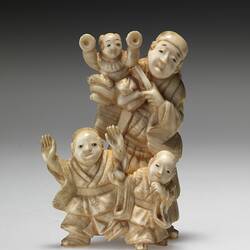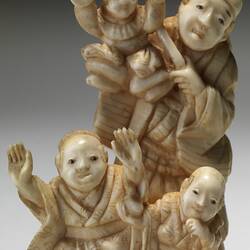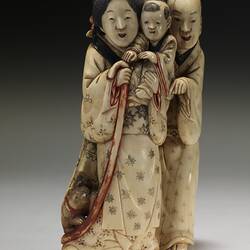Summary
Carved ivory group (okimono) of a puppet player and two children, manufactured in Japan in the early Meiji period (1868-1880).
An okimono is an small, carved Japanese decorative object created specifically for display, and typically depicts domestic scenes of farmers, fishermen, and children and occasionally, studies of birds, animals and flowers.
Similar to, but larger than netsuke - which served a practical function as a fastener or toggle - okimono were often presented in the tokonoma, an interior alcove or recesss in Japanese homes for the display of pictures or decorative art objects. During the Meiji period (1868-1912), many okimono were made for export to the west.
Physical Description
Ivory carving of a puppet player holding a puppet with two small symbols, with two young children standing at his feet. No markings.
More Information
-
Collection Names
-
Collecting Areas
-
Acquisition Information
Cultural Gifts Donation from Dr Will Twycross, 23 Jan 2009
-
Acknowledgement
Donated through the Australian Government's Cultural Gifts Program
-
Place & Date Made
Japan, 1868-1880
early Meiji Period; Edo Period, 1603-1867; Meiji Period, 1868-1912 -
Place & Date Exhibited
Royal Exhibition Building (REB), Nicholson Street, Carlton, Greater Melbourne, Victoria, Australia, 1880-1881
-
Collector
Mr John Twycross, Elsternwick, Greater Melbourne, Victoria, Australia, 1881
-
Classification
Royal exhibition building, International exhibitions, Exhibition heritage
-
Category
-
Discipline
-
Type of item
-
Overall Dimensions
40 cm (Width), 25 cm (Depth), 70 cm (Height)
-
Maximum dimensions
47 mm (Width), 70 mm (Height)
Measurement From Conservation.
-
Keywords
Decorative Arts, Exhibitions: Melbourne International, 1880-1881, Ivory, Japanese Art, Japanese Culture, Royal Exhibition Building, Royal Exhibition Building: History of Events, 1879-1899




